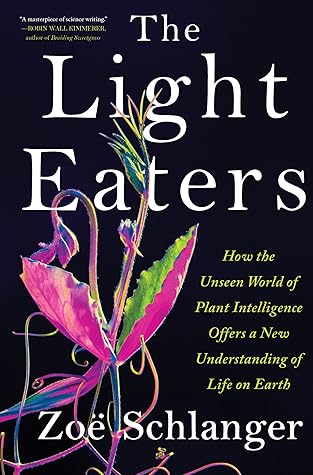More on this book
Community
Kindle Notes & Highlights
Read between
July 18 - July 30, 2025
But plants don’t just have receptors for red light. Botanists have thus far found fourteen types of light receptors in plants, each of which contribute vital information; some allow a plant’s shoots to grow toward light, and others help it avoid damaging UV rays. But many of the photoreceptors remain unexplained.
Boquila, a truly dynamic chameleon, was the first species found to imitate more than one other plant.
Humans, too, are composite organisms, he reminds me: our own microbiomes appear to govern many aspects of our health, and possibly even our psychology. “They’re related to digestion, allergies, even certain psychological disorders,” he says.
I remember when I first learned that human beings had microbial clouds hovering in the air around them at all times. I’d been sitting at my desk on the fifth floor of a corporate building in lower Manhattan for five hours when the data scientist James Meadow told me I’d probably shed millions of microbes all over my cubicle that day. “You know the dirty kid from Peanuts? Pig-Pen? It turns out we all look like that,” Meadow said into the phone.
In other words, our microbes might mediate how we think and feel. Our own cells are likely outnumbered by our microbial tenants. Upon closer examination, our individuality—what makes us ourselves—may look quite a bit more like a contained democracy than an autonomous dictatorship.
Crucial traits of animals, including how fast they grow and how they behave, have been found in recent years to be the result of microbial signals.
Boquila grows natively only in Chile, but it could apparently copy plants that had absolutely no connection to that part of the world. The mimicry phenomena was intrinsic to the entire species, then, and would express itself no matter where a plant went. That was spontaneous as hell.
Plants are composites of interpenetrating forms of life that resist an either-or classification. Perhaps much like us.
Plants clearly can recognize their kin. But how they do this—through which sensory channels—is an ongoing line of inquiry, in part because the means appear to be various.
The implication of kin recognition is that plants have a social life. They are aware of who they are in the company of, and decide how to behave toward them accordingly.
“It’s like a taboo,” he says, to apply social theory to plants.
Seeds take the gamble of their lives when they decide to emerge. They can often wait months or years for the right conditions. Those conditions are not only things like moisture and heat; their neighbors are also variables that can impact a seed’s potential survival into plant adulthood. A seed evidently knows that.
Fungal threads are hooked into the roots of nearly every plant grown in the wild, and may be crucial to the way plants communicate with one another belowground. The amino acids glutamate and glycine, important neurotransmitters in our brains and spines that are recently understood to be important to plant signaling, actually pass between plants and fungi at the junctures where the two connect.
The sweetness of tomatoes, the aromatic qualities of basil, and the properties of the essential oil in mint have all been shown to change depending on the species of fungi the plant grows with. The concentrations of medicinal compounds in echinacea, the aromatics in patchouli, and the antioxidant power of artichoke heads have all been found to increase with the presence of certain fungal associates too. The list goes on and on. Where a plant ends and a fungi begins becomes hard to parse.
Roots in the soil approach each other, retreat from each other, avoid each other, touch each other.
The environment a person experienced—in this case, what they ate—had a place in the story too. Possibly even a bigger place than genes.
The traits of the community change, based on the changing environment. But if you zoom in on a single plant, the same is true.


